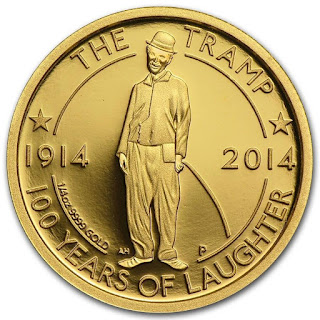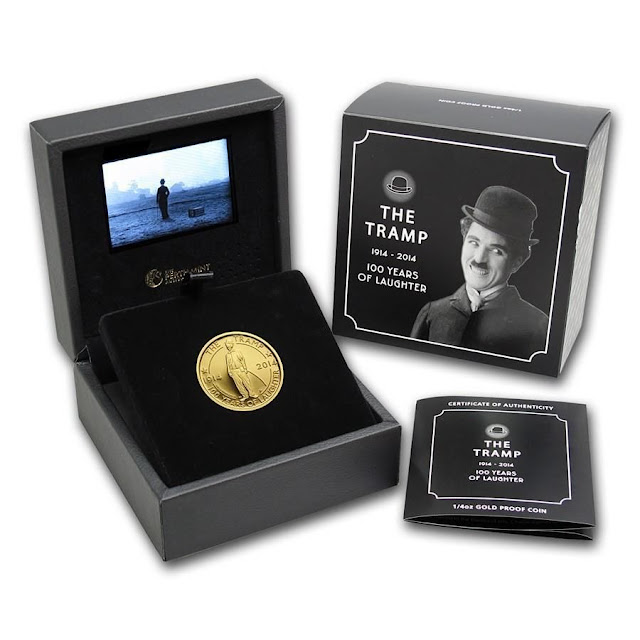Tuvalu 25 Dollars Gold Coin 2014 Charlie Chaplin, The Tramp – 100 Years of Laughter
Celebrating 100 years since Charlie Chaplin’s first movie appearance and the debut of his onscreen character The Tramp, The Perth Mint is proud to present this stunning commemorative.
The coin honours the life of British actor and filmmaker, Sir Charles Spencer "Charlie" Chaplin KBE (Knight Commander of the Most Excellent Order of the British Empire). A master of mime and a comic genius, his stage persona The Tramp became a global phenomenon, providing decades of laughter to audiences all over the world.
Each coin is struck by The Perth Mint from 1/4oz of 99.99% pure gold in proof quality. Just 1,000 of the Charlie Chaplin – 100 Years of Laughter 2014 1/4oz Gold Proof Coins have been released.
Issued as legal tender under the authority of the Government of Tuvalu, the coin features the Ian Rank-Broadley effigy of Her Majesty Queen Elizabeth II, the monetary denomination and the 2014 year-date on its obverse.
The reverse of the 1/4oz gold coin displays a struck portrait of Charlie Chaplin as The Tramp, surrounded by the words THE TRAMP, 100 YEARS OF LAUGHTER, and the year dates 1914 and 2014.
Each gold coin is housed in a prestigious MP4 box which plays a short film clip to music from the silent film, The Circus, when the lid of the case is opened. Each release is accompanied by a numbered Certificate of Authenticity.
Country: Tuvalu.
Year: 2011.
Face Value: 25 Dollars.
Metal: Gold.
Fineness: .999.
Weight: 1/4oz (7.776g).
Size: 20.60 mm.
Thickness: 2.10 mm.
Mintage: 1000 pcs.
Charlie Chaplin
Sir Charles Spencer "Charlie" Chaplin, KBE (16 April 1889 – 25 December 1977) was an English comic actor, filmmaker, and composer who rose to fame in the silent era. Chaplin became a worldwide icon through his screen persona "the Tramp" and is considered one of the most important figures in the history of the film industry. His career spanned more than 75 years, from childhood in the Victorian era until a year before his death in 1977, and encompassed both adulation and controversy.
Chaplin's childhood in London was one of poverty and hardship. As his father was absent and his mother struggled financially, he was sent to a workhouse twice before the age of nine. When he was 14, his mother was committed to a mental asylum. Chaplin began performing at an early age, touring music halls and later working as a stage actor and comedian. At 19 he was signed to the prestigious Fred Karno company, which took him to America. Chaplin was scouted for the film industry, and began appearing in 1914 for Keystone Studios. He soon developed the Tramp persona and formed a large fan base. Chaplin directed his own films from an early stage, and continued to hone his craft as he moved to the Essanay, Mutual, and First National corporations. By 1918, he was one of the best known figures in the world.
In 1919, Chaplin co-founded the distribution company United Artists, which gave him complete control over his films. His first feature-length was The Kid (1921), followed by A Woman of Paris (1923), The Gold Rush (1925), and The Circus (1928). He refused to move to sound films in the 1930s, instead producing City Lights (1931) and Modern Times (1936) without dialogue. Chaplin became increasingly political, and his next film, The Great Dictator (1940), satirised Adolf Hitler. The 1940s were a decade marked with controversy for Chaplin, and his popularity declined rapidly. He was accused of communist sympathies, while his involvement in a paternity suit and marriages to much younger women caused scandal. An FBI investigation was opened, and Chaplin was forced to leave the United States and settle in Switzerland. He abandoned the Tramp in his later films, which include Monsieur Verdoux (1947), Limelight (1952), A King in New York (1957), and A Countess from Hong Kong (1967).
Chaplin wrote, directed, produced, edited, starred in, and composed the music for most of his films. He was a perfectionist, and his financial independence enabled him to spend years on the development and production of a picture. His films are characterised by slapstick combined with pathos, typified in the Tramp's struggles against adversity. Many contain social and political themes, as well as autobiographical elements. In 1972, as part of a renewed appreciation for his work, Chaplin received an Honorary Academy Award for "the incalculable effect he has had in making motion pictures the art form of this century". He continues to be held in high regard, with The Gold Rush, City Lights, Modern Times, and The Great Dictator often ranked on industry lists of the greatest films of all time.
The Tramp
The Tramp is Charlie Chaplin's sixth film for Essanay Studios and was released in 1915. Directed by Chaplin, it was the fifth and last film made at Essanay's Niles, California studio. The Tramp marked the beginning of The Tramp character most known today, even though Chaplin played the character in earlier films. This film marked the first departure from his more slapstick character in the earlier films, with a sad ending and showing he cared for others, rather than just himself. The film co-stars Edna Purviance as the farmer's daughter and Ernest Van Pelt as Edna's father. The outdoor scenes were filmed on location near Niles.
The Tramp (Charlie Chaplin) finds the girl of his dreams and works on a family farm. He helps defend the farm against criminals, and all seems well, until he discovers the girl of his dreams already has a boyfriend. Unwilling to be a problem in their lives, he takes to the road, though he is seen skipping and swinging his cane as if happy to be back on the road where he knows he belongs.
Like many American films of the time, The Tramp was subject to cuts by city and state film censorship boards. For example, the Chicago Board of Censors cut, in Reel 1, the scene of Chaplin sitting in a sewage drainage pipe after burning his posterior.
The Tramp, as portrayed by Chaplin, is a childlike, bumbling but overall good-hearted character who is most famously portrayed as a vagrant who endeavors to behave with the manners and dignity of a gentleman despite his actual social status. However, while he is ready to take what paying work is available, he also uses his cunning to get what he needs to survive and escape the authority figures who will not tolerate his antics. Chaplin's films did not always portray the Tramp as a vagrant, however. The character ("The Little Fellow," as Chaplin called him) was rarely referred to by any names onscreen, although he was sometimes identified as "Charlie" and rarely, as in the original silent version of The Gold Rush, "The Little funny Tramp".
The character of the Tramp was originally created by accident while Chaplin was working at Mack Sennett's Keystone Studios, when dressing up for the short film Mabel's Strange Predicament starring Mabel Normand and Chaplin. That was actually the first film featuring the Tramp but a different film, shot later but with the same character, happened to be released two days earlier. The Tramp debuted to the public in the Keystone comedy Kid Auto Races at Venice (released on February 7, 1914; Mabel's Strange Predicament, shot earlier, was released on February 9, 1914). Chaplin, with his Little Tramp character, quickly became the most popular star in Keystone director Mack Sennett's company of players. Chaplin continued to play the Tramp through dozens of short films and, later, feature-length productions (in only a handful of other productions did he play characters other than the Tramp).
The Tramp was closely identified with the silent era, and was considered an international character; when the sound era began in the late 1920s, Chaplin refused to make a talkie featuring the character. Another reason was, the character was supposed to be American, and Chaplin himself had a strong and obvious British accent. The 1931 production City Lights featured no dialogue. Chaplin officially retired the character in the film Modern Times (released February 5, 1936), which appropriately ended with the Tramp walking down an endless highway toward the horizon. The film was only a partial talkie and is often called the last silent film. The Tramp remains silent until near the end of the film when, for the first time, his voice is finally heard, albeit only as part of a French/Italian-derived gibberish song. This allowed the Tramp to finally be given a voice but not tarnish his association with the silent era.
The physical attributes of the Tramp include a pair of baggy pants, a tight coat, a small bowler hat, a large pair of shoes, a cane and the famous small mustache. The Tramp walks strangely and uncomfortably because of the ill-fitting clothing; either he is wearing secondhand clothes, or they are originally his but he cannot afford new ones. The Tramp may have seen better days, but he maintains the attitude and demeanor of a high-class individual; as long as he acts like one he can believe that he is one, and is able to keep his hope that some day he actually will be again.


